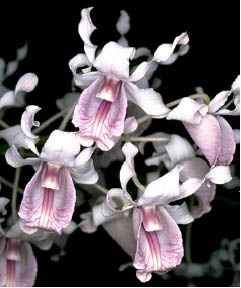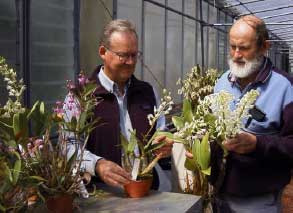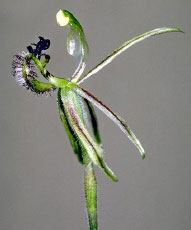 Archive document, 2005
Archive document, 2005
Adapted for the web from a double-sided hand-out sheet prepared by CSIRO Plant Industry Public Relations Unit in 2005.
Revealing the secret life of orchids
Known for their often exquisite flowers,orchids are the largest family of flowering plants in the world with over 30,000 species identified.They are distributed in most countries and are especially prolific in tropical regions,where the majority of species grow on the trunks and branches of trees.In temperate regions,such as southern Australia,most orchids grow in the ground.
In Australia there are between 1,200 and 1,400 orchid species with 80 per cent of these not found anywhere else in the world.A number of these also have some extremely specialised adaptations not seen elsewhere in the orchid family.For example two species of native orchids spend their entire life-cycle underground,and many ground orchids from southern Australia have become so specialised that they deceive and lure the males of a single species of insect to their flowers to ensure pollination.
Working at the Centre for Plant Biodiversity Research (CPBR), a collaboration between CSIRO Plant Industry and the Australian National Botanic Gardens,is a dedicated team of scientists researching orchids in order to understand and conserve them.
Classifying orchids
An ongoing part of orchid research at the CPBR is to study the evolutionary relationships within and between groups to identify natural groups and to help provide classification systems of orchids.In so doing new species may be recognised and scientifically named.Study techniques range from simple comparisons of plants and flowers to detailed microscopic techniques and molecular extractions involving DNA.
Scientists studying orchids at the CPBR use the Australian National Herbarium orchid collection of 48,000 dried specimens, 19,500 spirit-preserved specimens and 18,500 cards of dissected flowers as well as the collection of live plants at the Australian National Botanic Gardens.
Native orchid conservation
Accurate classification of orchid species is critical to their conservation.For example, a localised or threatened species of orchid may look very similar to a widespread and common species.Its survival may be at risk if the differences between the two are not brought to the attention of conservation authorities.
CPBR also helps conserve orchids by researching cultivation techniques and seed propagation.
Collecting orchids
Licensed collectors send orchid specimens to the CPBR that they gather from the bush across Australia.The specimens are added to the herbarium collection and information about them databased.Through this collecting more than 500 new species have been recognised in the past 15 years and the distribution patterns and conservation needs of others have been determined.
Identifying orchids
The CPBR is developing an interactive key to help identify orchids that will contain pictures and information about them.
Due for completion at the end of 2005 the key will be available to amateur and professional botanists,students and orchid enthusiasts.
About the Interactive Key to Australian Orchid Genera
Orchid relationships
Throughout the life of an orchid it forms relationships with other organisms.Most importantly orchids rely on fungi to assist with the germination of seed,and in some cases continue to work with fungi throughout their life for their continuing health and development.Orchids may also grow on a host plant and depend on certain insects to pollinate them.
Orchid seed
Orchid seed is the smallest seed of all plants,taking more than 1.25 million seeds to weigh a single gram.A specific fungus allows orchid seed to germinate by effectively providing energy to it that the orchid can ’t provide itself.Other plants are self sufficient at this stage but not orchids. Scientists at the CPBR are working hard to understand this delicate and necessary interference of fungi that allows orchid seed to germinate.
Orchid – host – fungi
CPBR researchers are investigating a group of epiphytic orchids,or orchids that grow on trees,and their relationships,not only with their preferred host tree,but also with the fungi that they are dependent on.Similar studies are underway into a group of ground orchids which is widely distributed in Australia.Unravelling the complicated relationships orchids have with their host and fungi could reveal just why these plants have become so specialised and what the implications are if either the host or fungus are destroyed.
Pollination
Many species of orchids rely on very specific pollinating agents to ensure the pollination of their flowers.Working with orchids in their natural habitat,scientists at the CPBR are collaborating with other researchers to learn more about specific pollination relationships.
For futher information on orchids contact
Dr Mark Clements on 02 - 6246 5503
or email mark.clements@csiro.au
![An Australian Government Initiative [logo]](/images/austgovt_canbr_90px.gif)





